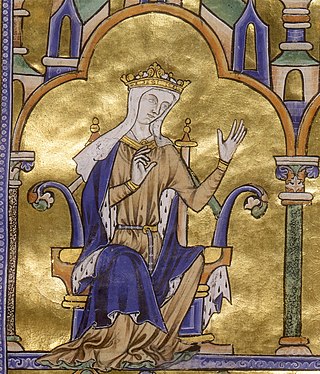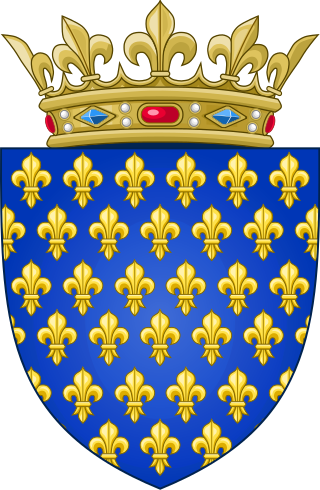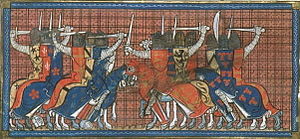
Alphonse was the Count of Poitou from 1225 and Count of Toulouse from 1249. As count of Toulouse, he also governed the Marquisate of Provence.

Isabella was Queen of England from 1200 to 1216 as the second wife of King John, Countess of Angoulême in her own right from 1202 until her death in 1246, and Countess of La Marche from 1220 to 1246 as the wife of Count Hugh.

Poitou was a province of west-central France whose capital city was Poitiers. Both Poitou and Poitiers are named after the Pictones Gallic tribe.

Blanche of Castile was Queen of France by marriage to Louis VIII. She acted as regent twice during the reign of her son, Louis IX: during his minority from 1226 until 1234, and during his absence from 1248 until 1252.

Poitou-Charentes was an administrative region on the southwest coast of France. It is part of the new region Nouvelle-Aquitaine. It comprised four departments: Charente, Charente-Maritime, Deux-Sèvres and Vienne. It included the historical provinces of Angoumois, Aunis, Saintonge and Poitou.
Angoulême (L'Angoumois) in western France was part of the Carolingian Empire as the kingdom of Aquitaine. Under Charlemagne's successors, the local Count of Angoulême was independent and was not united with the French crown until 1308. By the terms of the Treaty of Brétigny (1360) the Angoumois, then ruled by the Counts of Angoulême, was ceded as English territory to Edward III. In 1371 it became a fief of the Duke of Berry, before passing to Louis I, Duke of Orleans, both of whom were cadets of the French royal family. From then on it was held by cadets of the Valois House of Orleans, until Francis, Count of Angoulême, became King of France in 1515. Angoumois was definitively incorporated into the French crown lands, as a duchy.

Raymond VII was Count of Toulouse, Duke of Narbonne and Marquis of Provence from 1222 until his death.

The House of Lusignan was a royal house of French origin, which at various times ruled several principalities in Europe and the Levant, including the kingdoms of Jerusalem, Cyprus, and Armenia, from the 12th through the 15th centuries during the Middle Ages. It also had great influence in England and France.

The House of Capet ruled the Kingdom of France from 987 to 1328. It was the most senior line of the Capetian dynasty – itself a derivative dynasty from the Robertians.

The County of Saintonge, historically spelled Xaintonge and Xainctonge, is a former province of France located on the west central Atlantic coast. The capital city was Saintes. Other principal towns include Saint-Jean-d'Angély, Jonzac, Frontenay-Rohan-Rohan, Royan, Marennes, Pons, and Barbezieux-Saint-Hilaire.

Hugh X de Lusignan, Hugh V of La Marche or Hugh I of Angoulême was Seigneur de Lusignan and Count of La Marche in November 1219 and was Count of Angoulême by marriage. He was the son of Hugh IX.

The Saintonge War was a feudal dynastic conflict that occurred between 1242 and 1243. It opposed Capetian forces supportive of King Louis IX's brother Alphonse, Count of Poitiers and those of Hugh X of Lusignan, Raymond VII of Toulouse and Henry III of England. The last hoped to regain the Angevin possessions lost during his father's reign. Saintonge is the region around Saintes in the centre-west of France and is the place where most of fighting occurred.

The Château de Taillebourg is a ruined castle from the medieval era. It is built on a rocky outcrop, overlooking the village of Taillebourg and the valley of the river Charente, in the Charente-Maritime department of France. It commanded a very strategic position and was therefore the focus of much conflict throughout the medieval era.

The Ramnulfids, or the House of Poitiers, were a French dynasty of Frankish origin ruling the County of Poitou and Duchy of Aquitaine in the 9th through 12th centuries. Their power base shifted from Toulouse to Poitou. In the early 10th century, they contested the dominance of northern Aquitaine and the ducal title to the whole with the House of Auvergne. In 1032, they inherited the Duchy of Gascony, thus uniting it with Aquitaine. By the end of the 11th century, they were the dominant power in the southwestern third of France. The founder of the family was Ramnulf I, who became count in 835.
Hugh XI de Lusignan, Hugh VI of La Marche or Hugh II of Angoulême was a 13th-century French nobleman. He succeeded his mother Isabelle of Angoulême, former queen of England, as Count of Angoulême in 1246. He likewise succeeded his father Hugh X as Count of La Marche in 1249. Hugh XI was the half-brother of King Henry III of England.
The crown lands, crown estate, royal domain or domaine royal of France were the lands, fiefs and rights directly possessed by the kings of France. While the term eventually came to refer to a territorial unit, the royal domain originally referred to the network of "castles, villages and estates, forests, towns, religious houses and bishoprics, and the rights of justice, tolls and taxes" effectively held by the king or under his domination. In terms of territory, before the reign of Henry IV, the domaine royal did not encompass the entirety of the territory of the kingdom of France and for much of the Middle Ages significant portions of the kingdom were the direct possessions of other feudal lords.

The Capetian–Plantagenet rivalry was a series of conflicts and disputes that covered a period of 100 years (1159–1259) during which the House of Capet, rulers of the Kingdom of France, fought the House of Plantagenet, rulers of the Kingdom of England, over the Plantagenet-held Angevin Empire which at its peak covered around half of the territory within France. Some historians refer to this series of events as the "First Hundred Years' War".

Renaud II, also known as Reginald de Pontibus or Renaud de Ponz, was a French nobleman and the lord of Pons in the Saintonge region of the County of Poitou from 1191 until his death. In the Anglo-French dynastic conflict, he was a strong supporter of John, King of England. He left Poitou three times to fight infidels: the Third Crusade, the Reconquista in Spain and the Seventh Crusade. He is distinguished from his uncle, Renaud de Pons, Seneschal of Gascony, in contemporary documents by the epithets senior and junior. He is possibly the same person as the troubadour Rainaut de Pons.
Geoffroy III de Pons, Lord of Pons, was a 12th-century French noble.


















